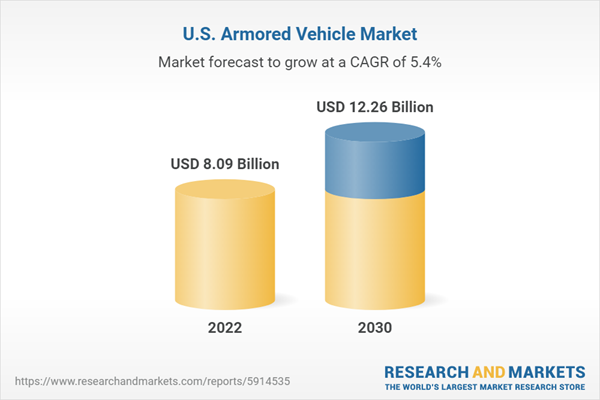and upgrade these vehicles with more advanced and capable counterparts, aligning with evolving defense requirements.
Key players and research agencies are focusing on developing innovative techniques to make armored defense vehicles more autonomous, maneuverable, lighter, and faster to increase the survivability of vehicles. Defense Advanced Research Projects Agency (DARPA) introduced the Ground X-Vehicle Technologies (GXV-T) program to improve the mobility and survivability of armored vehicles. Furthermore, various Western military forces have started upgrading their aging armored vehicle fleets, including Denmark, Poland, Canada, U.S., and U.K. Manufacturers are focusing on offering technologically advanced Armored Fighting Vehicles (AFVs) for the defense sector.
AFVs include highly explosive munitions, fire control systems, remote weapon systems, and active defense suites, among others. These technologies have further increased the demand for AFVs in the defense sector. Defense crew must remain inside the vehicles during attacks from Rocket-Propelled Grenades (RPG), mines, and Improvised Explosive Devices (IED) to improve their survivability. The increase in the number of Remote Weapon Stations (RWS) is enabling crews to operate weapons from the protected vehicle hull.
The demand for advanced protection against emerging threats is leading to the development of next-generation armored vehicles equipped with advanced armor systems and electronic countermeasures. These defenses are crucial in countering modern challenges such as kinetic energy penetrators and anti-tank-guided missiles. Besides military demand, there is a rising need for armored vehicles among law enforcement and security agencies. These organizations deploy armored vehicles to protect their personnel and assets from threats such as terrorism, drug trafficking, and organized crime. For instance, in April 2021, BAE Systems collaborated with the U.S. Army to provide two prototype vehicles for assessment as a potential remedy for the Cold Weather All-Terrain Vehicle (CATV) program. BAE Systems introduced Beowulf's all-terrain vehicle. It is built on tried-and-true techniques and can move people and goods in the most difficult and isolated environments.
Beowulf is a tracked, unarmored, extremely adaptable vehicle that can traverse even the most difficult terrains while transporting people and supplies in either of its two compartments. Beowulf's efficiency is articulated by the mobility system, which provides ideal maneuverability on a variety of terrain. Additionally, it is modular in design and may be set up for a variety of tasks, including search and rescue, disaster and humanitarian aid, logistical support, and other tasks as needed.
U.S. Armored Vehicle Market Report Highlights
- The manned armored vehicles segment led the market in 2022, accounting for over 86% share of the revenue, driven by escalating geopolitical tensions and conflicts. This segment's growth is fueled by the rising threat of terrorism and asymmetric warfare, as armored vehicles offer vital protection for personnel and equipment in high-risk settings.
- The wheeled segment led the market in 2022, accounting for over 83% of revenue. The segment's growth is attributed to the versatility and mobility of wheeled vehicles. Wheeled armored vehicle, being lighter and faster than tracked ones, are better suited for a wide range of military operations.
- The electric armored vehicles segment is expected to showcase significant growth over the forecast period. The integration of advanced electric powertrains in armored vehicles enhances their performance, agility, and versatility. The immediate torque offered by electric propulsion ensures rapid acceleration and improved off-road capabilities. These vehicles are also quieter in operation, offering a stealth advantage in surveillance and reconnaissance missions.
Table of Contents
Companies Profiled
- Bae Systems
- Bmw Ag
- Mercedes-Benz Group Ag
- Elbit Systems Ltd..
- Ford Motor Company
- General Dynamics Corporation
- Inkas Armored Vehicle Manufacturing
- International Armored Group
- Iveco Group N. V
- Krauss-Maffei Wegmann Gmbh & Co. (Kmw)
- Lenco Industries, Inc
- Lockheed Martin Corporation
- Navistar, Inc.
- Oshkosh Defense, Llc
- Rheinmetall Ag
- Stat, Inc.
- Textron, Inc.
- Thales Group.
Methodology

LOADING...
Table Information
| Report Attribute | Details |
|---|---|
| No. of Pages | 200 |
| Published | November 2023 |
| Forecast Period | 2022 - 2030 |
| Estimated Market Value ( USD | $ 8.09 Billion |
| Forecasted Market Value ( USD | $ 12.26 Billion |
| Compound Annual Growth Rate | 5.4% |
| Regions Covered | United States |
| No. of Companies Mentioned | 18 |









